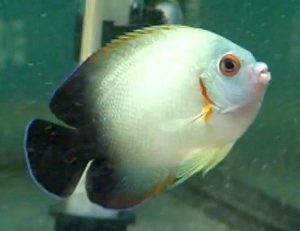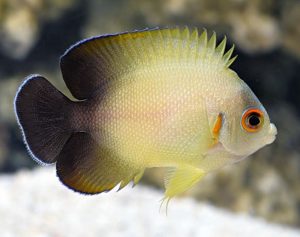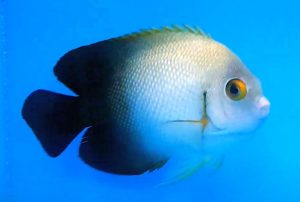The Half Black Angelfish (Centropyge vroliki) known to tropical fish keeping enthusiasts as the Half Black Pygmy Angelfish or Pearlscale Angelfish is found in the in the Western Pacific from Japan to the Great Barrier Reef; including the Christmas Islands.
Most Half Black Angelfish sold in the aquarium trade are taken from Indonesian and Indian Ocean waters. Because they are less aggressive than other dwarf angelfish species and more likely to behave themselves among other residents; tropical fish keeping enthusiasts consider them an excellent addition to mixed species and reef aquariums.
Centropyge vroliki as the name implies are half black. The front part of their body is covered with light gray to pearl colored scales that fade into a deep black coloration that covers the back portion of the body. The anal, caudal, and rear half of the dorsal fins are outlined in a bright baby blue color and the entire black and white pattern is accented by a yellow to yellow orange coloring.
Half Black Angelfish posses an orange ring around the eye, an orange blotch in the middle to the rear of the gill cover, and yellowish accents on the pectoral and front half or the dorsal fins. Males are indistinguishable from females. Because Half Black Angelfish are well known for cross breeding with Eibli and Lemonpeel angelfish, some beautiful and interesting hybrids are occasionally seen in the hobby.
Provided with enough space, Dwarf Half Black Angelfish are generally peaceful and behave themselves in a community environment, however, when crowded they can become feisty and aggressive, especially with members of their own species and with similar looking fish.
When Half Black Angelfish are housed with larger or more aggressive fish and get bullied; they quickly become passive, lethargic, and may even act more peaceful. They do best in a tank with plenty of swimming room and live rock arranged into places where they can quickly hide, especially when there is more than one dwarf angelfish in the same aquarium.
Although a single juvenile Half Black Angelfish can be housed in an “aged” 30 gallon tank, they do much better in an aged aquarium of at least 55 gallon capacity, or even larger; especially if you are keeping a mated pair of this species. An “aged aquarium” should be at least 6 months old and have a substantial growth of algae to provide the necessary diet to feed your angelfish.
A well aquascaped reef setting with a large amount of cured live rock arranged into shelters, archways, overhangs, and hiding places will provide enough grazing area for the microalgae growth necessary to maintain the health of the fish, however, adult Half Black Angelfish are constant grazers and will slowly eat away at some of the reef structure making them not entirely “reef safe”. When not fed properly, they often begin feeding on polyps, soft corals, and clam mantles.
Water quality is essential to all marine residents, so regulator water changes are mandatory. In an aquarium of 55 to 65 gallon capacity, a 10% to 15% bi weekly water change is recommended. Because Half Black Angelfish are constant grazers, water changes should NOT include scrubbing algae off of the interior of the aquarium.
Although Half Black Angelfish have been bred in an aquarium environment, their larvae are extremely difficult to raise. All angelfish are born as females and as they grow the larger, the most dominant fish will transform into a male.
The best way to obtain a mated pair is to keep several juvenile specimens together. It usually takes 2 or 3 months before a female will turn into a male and pair up. Becomes the larger fish turns into a male, making a pair is possible by purchasing a larger Half Black Angelfish and keeping it with a smaller one. Within a few months they will usually assume their roles as male and female. Their mating ritual is similar to that of the Lemonpeel Angelfish which they readily cross breed with in the wild.
Centropyge vroliki is well known for cross breeding with Centropyge eibli (Eibli Angel) and Centropyge flavissima (Lemonpeel Angel) which both make good tank mates if they are added to the aquarium at the same time.
In their natural habitat, Half Black angelfish graze on algae and feed on small crustaceans that hide in the algae. Juveniles are predominately plankton eaters that switch to a microalgae and crustacean diet as they become adults. In a well established aquarium environment with plenty of cured live rock, Centropyge vroliki are good eaters that can be fed spirulina flakes, omnivore pellets, leafy greens, frozen mysis shrimp
, and other meaty crustaceans like clams and shrimp. Feed 2 to 3 times daily.
Although juveniles are considered fairly safe for reef tanks, as they grow they can develop a taste for soft coral polyps, brain corals, zoanthids, and clam mantles. Keeping them well fed will usually avoid this problem. Half Black Angelfish will not bother crabs or shrimp in a reef tank.
Tropical fish keeping enthusiasts can obtain Half Black Angelfish (Centropyge vroliki) from fish shops, importers, online auction sites, and a variety of online retail sources at relatively reasonable prices. Approximate purchase sizes online will vary from Small: 1″ to 1-3/4″; Medium: 1-3/4″ to 2-1/2″; to Large: 2-1/2″ to 4″.
Minimum Tank Size: 55 gallons
Aquarium Type: Cautiously Reef Compatible
Care Level: Moderate
Temperament: Semi-aggressive
Aquarium Hardiness: Hardy
Water Conditions: 72-78°F, dKH 8 to 12 , pH 8.1 – 8.4, sg 1.020-1.025
Max. Size: 4″
Color Form: Black, Pearl
Diet: Omnivore
Compatibility: Single species
Origin: Indonesia
Family: Pomacanthidae
Lifespan: 12 years
Aquarist Experience Level: Intermediate





